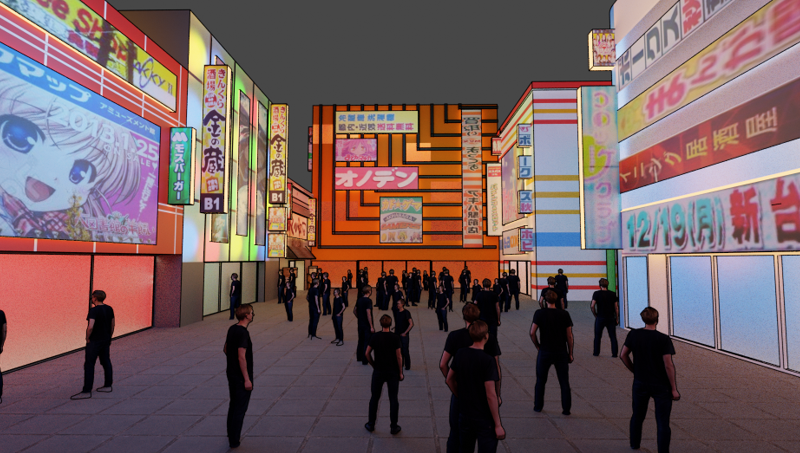
Virtual shopping centre Metajuku in Decentraland metaverse
Mark Zuckerberg made the headlines when he said in June that Facebook would become a “metaverse company“, or strive to build a “maximalist”, interconnected set of experiences straight out of sci-fi.
Gamers also said they are entering metaverse with NFT-driven games like Axie Infinity or CryptoKitties. It indicates the play-to-earn economy is becoming a global phenomenon.
As for metaverse, you can imagine it as a single, persistent and connected virtual environment shared by everyone (in the form of a “digital avatar”). Non-fungible tokens (NFT)-based games are the pioneering version of this metaverse.
“Virtual identity has become an extension of our physical identity as we spend so much time on the Internet for shopping, socialising, etc.,” said TJ Kawamura, partner at Republic Realm. “I think the metaverse is a natural evolution to that.”
Based out of the US, Republic Realm is a digital real estate investment and an investor in the metaverse.
This evolution of the metaverse goes along with the bubble-associated NFTs, or programmable blockchain-based records that uniquely represent digital arts such as videos, music, or goods.
The Google Trends data shows that NFTs are gaining steam, with global interest jumping 426 per cent in August 2021. Experts consider this a stepping stone for the not-too-distant metaverse, where digital assets can secure their scarcity and values through verifiable randomness.
Also read: The art of blockchain: What is the NFT craze all about?
Realising this future, investors are betting big on this with hundreds of millions of dollars. For instance, Republic Realm recently bought virtual land in the decentraland metaverse for a record US$913,000 in June.
So far, Republic Realm has acquired more than 1,700 parcels across eight metaverses, including Axie Infinity, The Sandbox, Decentraland, Cryptovoxels, and Somnium Space.
Earlier in April, Epic Games, the owner of the famous battle royale video game Fortnite, raised US$1 billion from a slew of investors to pursue its metaverse ambition.
It is not unrealistic to anticipate an alternative universe that simulates a new reality amplified from the existing one. Ready Player One sci-fi novel’s OASIS — a virtual universe where people stay to escape the real problematic world in 2045 — is the nearest example of this concept.
“It is still early days for the metaverse,” Janine Yorio, managing director at Republic Realm, told e27. “However, we believe a convergence of fundamental shifts in technology, society, socialisation, gaming, and retail provide significant tailwinds for mass metaverse adoption and development”.
People are working to achieve this goal step by step. Developers still need more time to break down the technical hurdles to set up the immersive system with augmented reality and virtual reality (VR/AR) applications and troves of hardware production.
But can you afford to miss this dream-come-true opportunity?
Here are some of the roles that you could take when jumping on the bandwagon.
A player in a digital in-game world
Gaming has always paved the way for adopting various revolutionary technologies, from Pokémon Go with AR to Farmville with social media (Facebook) or simple digital card games that get you accustomed to PC.
Axie Infinity, Animoca Brands, or Fortnite are some prominent players bridging the gap between millions of people and the immersive digital experience of a future metaverse.
Within these in-game environments, people are not only attracted to the gameplay as a recreational activity, but they can also socialise with other people, create their own assets, trade them and earn real-life money.
This, however, comes with a challenge to build an appealing play-to-earn model, especially when a portion of players only go to NFT-based games for financial gains.
Tin Nguyen, the founder of blockchain game Sipher, said that there were case studies of some crypto native games which had acquired millions of users too fast but then went out of tokens after few months.
“The most important part is it has to be a game that is fun to play. It has to be a game that attracts people because of the experience you’re providing and not because of the token or some financial value that you’re giving them for just grinding game,” said Nguyen in a recent event on the future of NFT sales in the metaverse.
Sébastien Bisch, general manager of Novaquark, the developer of sci-fi massively multiplayer online (MMO) game Dual Universe, speaks of another challenge: the limited types of virtual experience in the modern games industry — a step away from a truly unified, persistent game world of a metaverse.
“Very few games have tried to propose a unified, persistent game world for all players. Even when they did, the scalability was extremely limited with a cap to the number of players able to play in the same area,” said Bisch, as cited by gamesindustry.biz.
Fortnite, for instance, has to spread users across different servers and therefore does not bring everyone to the same virtual place of an in-game event as we expect with an ideal parallel universe.
A worker in “a level playing field”
CoinDesk recently reported that a Filipino earned around 10,000 PHP (US$206) per week from playing Axie Infinity around the clock and considered earning SLP (Axie Infinity’s in-game utility token) as his full-time job. He then inspired 100 more people in his local community to play since the pandemic deprived people of their jobs.
Metaverse Filipino Worker (MFW) then becomes a new career option in the country. The metaverse turned into a workplace that people could reach with a smartphone and an internet connection.
“People are making more money than they would in their local economies,” said Kawamura of Republic Realm. “That’s creating a level-playing field when it comes to being able to make money from anywhere.”
But what’s truly disruptive is that as metaverse leverages decentralised blockchain ledger and NFTs to ensure ownership and scarcity of digital assets, the artist community can now take full credit for their works. The community can easily trade them to global audiences and move the digital product from one metaverse to another without losing their commercial copyrights.
“It’s something that our art world has struggled with — their licenses and royalties,” said Yorio. “This idea of being able to trade things with a ledger tracking their legitimacy and making sure that they’re not counterfeit makes a lot of sense.”
Virtual artist Hiroto Kai created NFT art and digital clothing and sold them to the in-game players in the metaverse of Decentraland. In July, Sony Music Entertainment teamed up with the global gaming platform Roblox to help recording artists reach and monetise new audiences from Roblox’s 199+ million monthly active players.
As metaverse economies leverage the interaction between traditional cash economies and a digital in-game economy, people can now rely on that to put food on the table.

Wearables sold in metaverse (Decentraland)
Another topic that might transform the work of various professionals worldwide is how the omniverse employs the laws of physics to control factories, buildings, and infrastructures in the real world.
Omniverse is a simulation and collaboration platform that constitutes the foundation of the metaverse.
Manufacturing giants BMW Group and NVIDIA are on track to set new standards of virtual factory planning with these omniverses. They will employ a range of planning data and applications and allow real-time collaboration between virtual omniverse and physical facilities with unrestricted compatibility.
A consumer in an immersive business scenario
Over the past year, brands such as Gucci, Vans, Stella McCartney, Burberry, Coca-Cola, Netflix and Warner Bros have all set their foot on the metaverse ground to create brand awareness among younger users.
“This generation grows up doing things just like we are now interacting in Zoom. They’re more accustomed to immersive experiences when they use the Internet,” said Yorio. “The companies that fail to adapt will be left behind because the next generation of consumers is going to expect to find new products and their favourite old products in these immersive environments.”
Imagine walking down a street and seeing a Burberry accessory; you buy it, and then it appears with your avatar in a metaverse game. The same applies when you purchase an item in your metaverse game. There are entirely no boundaries between the physical world and a virtual universe.

Vans launched its own world within Roblox metaverse
Just as how the Internet arrived 25 years ago, it is high time for any consumer product/airline/hotel company to think about what metaverse means for their businesses.
Some are worried that when big shots such as Facebook publicly announce plans to build out their version of the metaverse, they will trounce any of the various companies building their ones.
“However, crypto is all about giving the representation back to the people; that is its core ethos,” noted Yoiro. “Decentralisation is what people are drawn to, so there may be pushback against a big player getting involved in the space.”
Yorio added that many metaverses utilise what is referred to as a DAO — a decentralised autonomous organisation. These act as the media for decision-making and can be joined by regularly contributing to the specific DAO’s community.
In the end, you are the one who would choose the role you play in the imminent metaverse, and your participation and engagement would define the development of this parallel world.
—
Image Credit: Republic, Decentraland
The post Metaverse is around the corner and you should play a role in it appeared first on e27.


HelloGreat post! I really enjoyed reading it. I was wondering if you could provide more information on this topic. I would greatly appreciate it if you could elaborate a bit further. Thank you so much!Stay well.
Your post was truly impressive, not only for its amazing content but also for the valuable insights it provided. I am eager to further explore this topic as it aligns with my strong interest in learning. Your expertise and unique perspective are greatly appreciated. Thank you for generously sharing your thoughts and taking the time to do so!Adios.